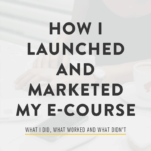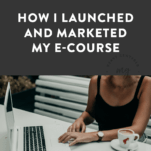Almost exactly one month ago today, I launched my first e-course, Pinfinite Growth. The course is designed to help bloggers lay a strong foundation for their site and then guides them through several modules of Pinterest strategies aimed at bringing more of the right visitors to their blogs. I’ve been blogging and running my own business for awhile, y’all, but even still, I was nervous that my course would fall flat. A part of me thought that “maybe only three people will sign up” and I’d feel so bad about it that I’d refund those three people and move to Alaska to live as an eskimo. Or, you know, maybe something a little less dramatic, like eating a pint of ice cream by myself.
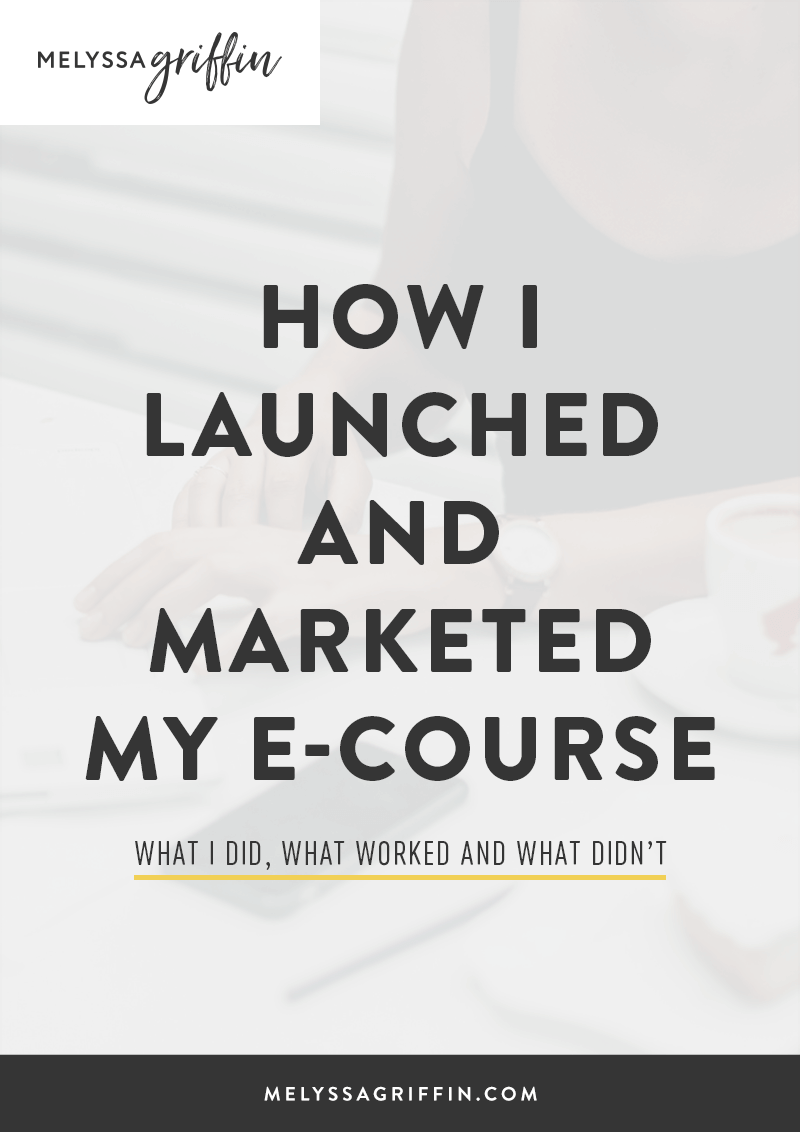
Actually, launching Pinfinite Growth was one of the best business decisions I’ve ever made. Since I launched the course 4 weeks ago, almost 150 people have signed up. And since we’re all friends here, I’ll tell you that that resulted in close to $30,000 in revenue. Holy shizzle. Three years ago, that number was closer to what I’d make in a year, not a month, so it left me a little dumbfounded and a lot excited.
Since I want you to have your own successful launches, I’m going to detail exactly what I did for the launch of my course — how I marketed it, which techniques brought the most revenue, and suggestions for your own launch. This post is MEATY y’all (vegan meat, if you’d like) — so I hope you’re sitting down. 😉 Let’s boogie!
First things first, here are the different platforms I used to market my course. I’m explaining exactly how I used them and what kind of results I saw from each platform. Woohoo! These aren’t in any particular order of awesomeness — just FYI.
1. Periscope
Periscope was the very first place that I mentioned my new course. During the week I mentioned it, I actually hosted a mini-series on Periscope, in which I hosted a Periscope event each weekday of that week, all based around a specific topic. The topic was “how to stand out online” and I covered topics ranging from SEO to Pinterest.
Pinterest was the final day in the series and after sharing some advice, I told everyone a little bit about the course I’d be launching on the following Monday. I also gave them a special link where they could sign up to learn more about the course and be offered a special bonus only for people who signed up from that link. After I launched the course, three of those people ended up signing up for the course.
2. Webinars
I hosted two webinars during the launch of my course. Wow, what an experience they were! I’ve been to webinars in the past where I felt like, instead of giving me useful information, they were just luring me there so they could sell something to me. Bleh. I didn’t want the people who came to my webinars to feel that way, so I took time to prepare free classes that were filled with useful information. I’m glad I did, because I received a lot of positive tweets and emails from people who felt like the webinars themselves could have been paid workshops. That made me feel like I was on the right path. (Also, it just made me want to give the internet a big, giant hug).
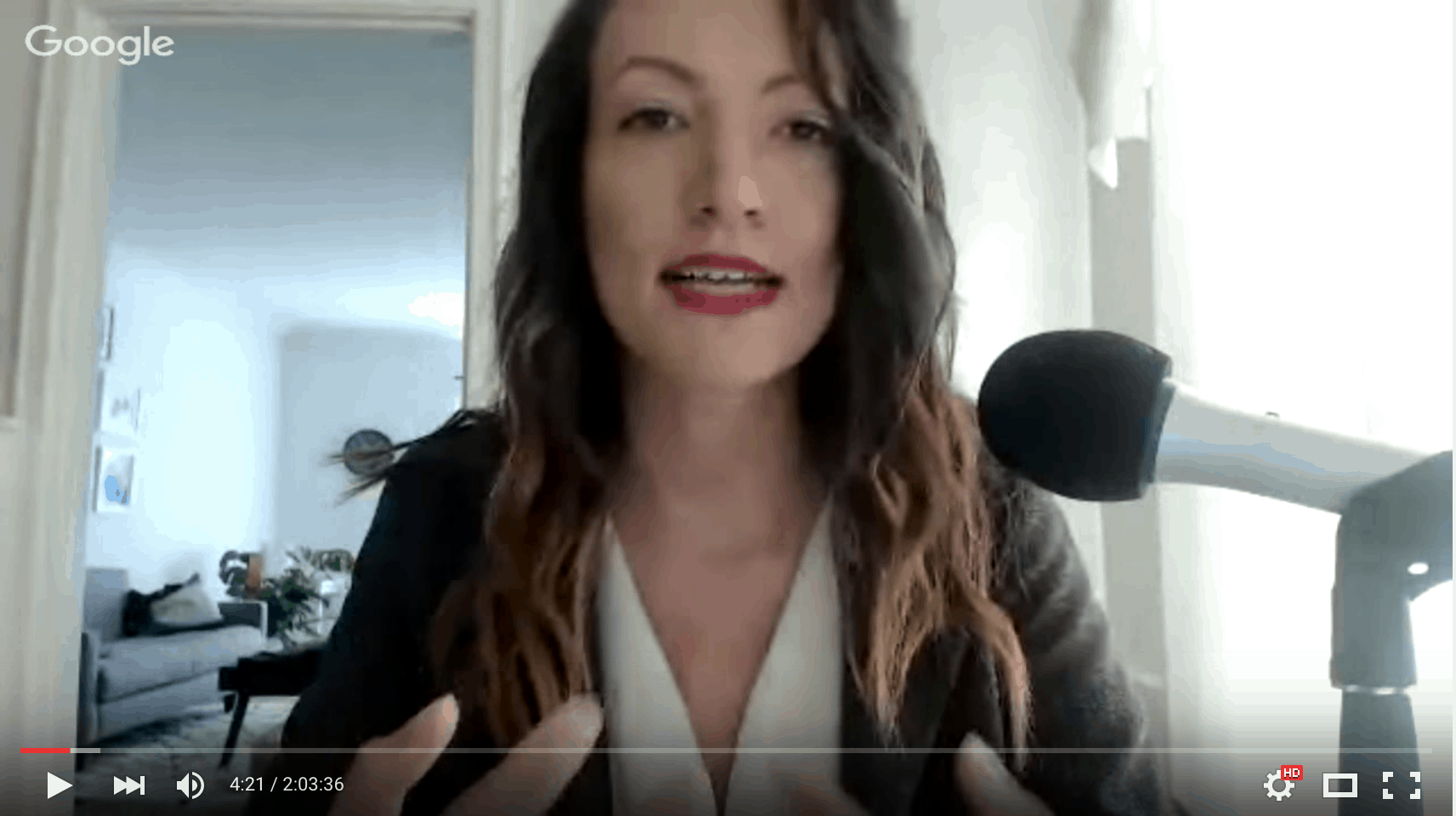
For each of my two webinars, I spent about 60-75 minutes teaching and about 10 minutes selling my course at the end. Since I was a newb during my first webinar, I didn’t create a trackable link so that I could see how many people signed up through the webinar. I definitely saw more sales than usual though, so I knew it was working.
Now, for my second webinar, I did create a trackable link (go me!) and found that 39 people registered for my course through that link. Holy bananas! My palms are getting sweaty just saying that, because it was so surprising and exciting to me. As awesome as webinars were for sales, they took an enormous amount of time to plan, market, and teach. I probably wouldn’t be able to realistically do more than two webinars a month.
P.S. If you want to learn how to do effective webinars, my friend, Mariah, has a killer course on them here.
3. My Email List
I have a primary email list that I use to send weekly emails to my crew. I didn’t want to alienate or annoy them, but I did want to make sure that I was utilizing this list, as I knew that emailing your list is a great way to sell your product.
Over the span of four weeks, I sent six emails to this list. Three of those emails were either directly related to Pinfinite Growth or incorporated the course into the email in some way. The other three mainly marketed upcoming webinars that I was going to be doing (where I would also mention my course). To be honest, I wasn’t very “strategic” about my launch planning. I had some ideas of things I wanted to do, but I didn’t create any sort of “plan” ahead of time. For my next launch, I’ll probably create more of a plan, mainly to help with my sanity (launching takes a lot out o’ ya!).
I wish I had kept better track of how many sales I made through my email list (and have been considering switching to an email provider that tracks these things more easily), but I can tell you that on days I did send an email, I would see a significant increase in sales. It does work, trust me.
**All in all, webinars and emailing my list were the two most profitable things I used to market my course. However, I’d say that my email list had the highest Return On Investment (ROI) because I grew my list fairly passively and it didn’t take long to write the “sales” emails that I sent to my list. On the contrary, webinars took a lot of time to plan, promote, and teach. I’m not saying you shouldn’t do webinars — I’ll definitely host them in the future — but I’m just letting you know the facts, yo.
4. Facebook Ads
I once looked at the “Power Editor” interface for Facebook Ads and probably spent the next several hours crying in a corner. It looks intimidating and isn’t incredibly straightforward. To compensate, I enrolled in FB Ads for Launching, which I heard about through another entrepreneur who found it extremely helpful. It definitely is helpful! The teacher, Farideh, really walks you through each step, which was awesome.
I created several ads to market my e-course and eventually narrowed it down to about two ads, which were performing the best. Overall, I received 16 conversions and spent $77. Since my course is about $200, that means I spent $77 and in turn made close to $3,200. Holy mackerel! I felt like I unlocked some sort of internet superpower. It was rad. This was my highest converting ad:
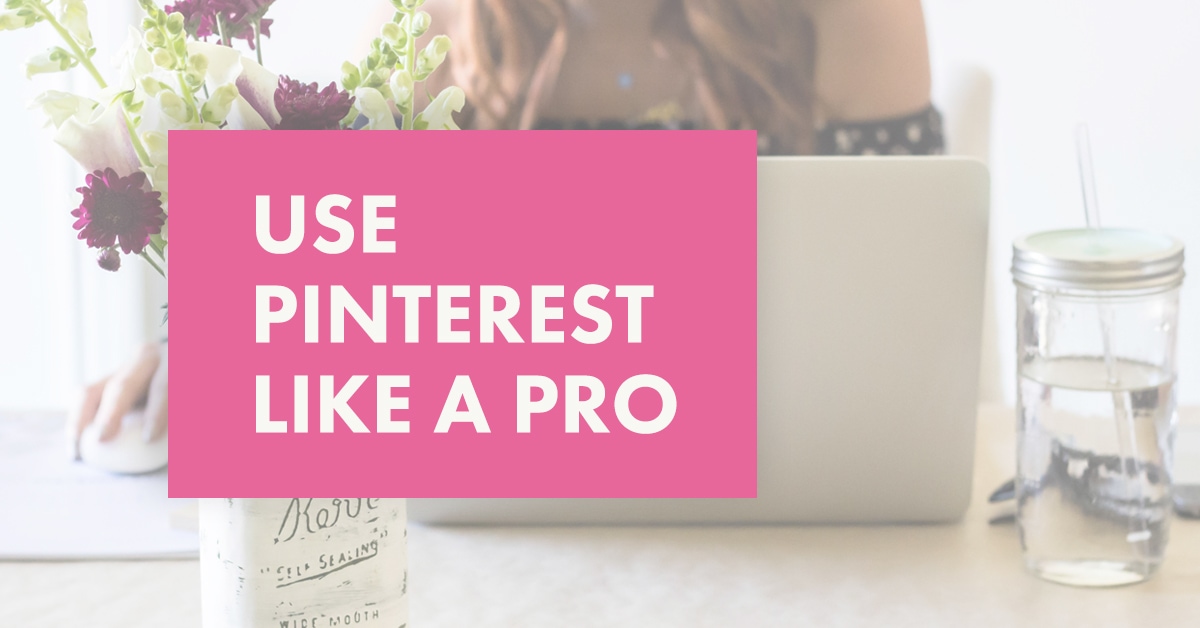
Now, on the flip side, I mainly marketed those Facebook ads to people on my newsletter list and people who visited the Pinfinite Growth sales page previously, but hadn’t purchased yet. Basically, people who were already familiar with me or the course. This could also mean that some of those people didn’t purchase directly through those Facebook ads.
Basically, the way FB ads work is that when someone clicks the ad, a tracking pixel is attached to them, so if they eventually purchase your product, it will show up as a conversion. So, that means that someone who clicked an ad could have later purchased my course after reading one of my newsletters or hearing about it on social media. Since I didn’t really market it to brand new audiences, I can’t really say whether the ads actually got people to buy, but I definitely think they helped and I will be using them again in the future.
5. Twitter Chat
Someone asked me awhile back if I started my biweekly Twitter Chat (#NectarChat) because it would be full of my ideal customers, who I could then sell to. I thought it was an interesting question because “selling” was probably the last thing on my mind when I created #NectarChat. Ha! But now that I was launching my course and had a solid Twitter chat community, it did feel like a smart idea to at least let them know the course exists.
Since #NectarChat is a place for bloggers and entrepreneurs to discuss strategies and advice, I created a Pinterest-themed #NectarChat. I mentioned my course a few times throughout the chat and offered a bonus for anyone who signed up that night. Five people ended up signing up for the course after #NectarChat.
Now, aside from leveraging my Twitter Chat to market my course, I didn’t do a whole lot of Twitter marketing. I did retweet things when students would share positive results, but that’s about it. I’d like to be a bit more intentional with this in the future.
6. Instagram
I wasn’t super active on Instagram during my launch, and I want to spend more time on Instagram for future launches. A few things I did right:
- I shared a “behind the scenes” video of the course website. This got a lot of comments and attention, which I think is due to the fact that it shows all the neat stuff they’d get access to if they enroll. I also don’t know if I’ve ever seen a BTS video for a course, so people may have liked it because it was something new. I didn’t track how many people purchased after watching that specific video, but two of the people who commented did end up signing up.
- I posted a convincing testimonial from a student. I was really happy to see in the private course Facebook group that students were sharing some incredible results after only one week of the course starting. I decided to turn one of those Facebook posts into a testimonial image, which I shared on Instagram.
Aside from those things, I shared some other Instagram images where I mentioned that I was hosting a webinar and included the sign-up link in my profile. I didn’t put a whole lot of time or strategy into Instagram, which I’d like to change for the future.
7. This blog + a giveaway
I honestly didn’t share the course very much on the blog because I figured most of my dedicated readers would be on my email list anyways. I wrote one post introducing the course and also shared a giveaway within that post, so that one person could win free entrance into the course (Congrats Stacia!). What I can tell you is that the day before I published this post, four people purchased the course. On the day I published it? Eight people purchased.
I’m honestly not sure how much the giveaway helped and wouldn’t consider it anything that really helped my sales, especially compared to the other things in this list.
8. Social Proof
This isn’t really a “thing I did to launch my course,” but I wanted to mention it because I think it’s crazy important. So, before I launched the actual course, I pre-sold it for about 2 weeks. During that presale period, I did make quite a few sales — likely from people who knew and trusted me. But once the course launched and students started seeing fast results, I made sure to share those results in webinars, with my email list, and on social media. I wanted other people to know that the course works.
If you’re launching something, then I strongly suggest sharing this “social proof” with your followers. I absolutely believe it will increase your sales, because it’s a lot more persuasive to see someone else talk positively about your course than to only see you talking about it. During the two weeks when I pre-sold my course, I didn’t have social proof yet, but if you’re smarter than me, you could have “beta testers” who try out your course either for free or a reduced price and can give you your first testimonials. Social proof works.
Why I chose to keep my course Evergreen instead of launching only a few times a year
Now, a lot of people choose to launch their courses only a few times a year rather than keep enrollment open indefinitely. That can be a great strategy, but I chose not to do that for a few reasons…
- I felt like I could make consistent sales throughout the year just by having it open for enrollment. To me, it felt like kind of a waste to create a course and then not make money from it.
- If people want to enroll when it’s not currently in “launch mode” then they’ll have to sign up for your email list and wait for it to be released again. This may build anticipation, but at the same time, it may also build disinterest. I feel that those customers who were really excited about your course may not be as excited if they have to wait three more months to enroll in it.
- I felt like it was the right thing to do for my audience. I didn’t want to stress them out if they couldn’t afford the course during a two-week launch window. I also know that new people discover my site pretty regularly, so I wanted them to have the chance to join if they wanted to.
Now, even though I’m keeping it evergreen, I do envision some “launch periods” from time to time where I will promote the course more (with webinars, emails, etc) than I would in a regular week.
Pre-selling vs. launching a finished course
After the suggestion from my friend, Mariah, I decided to pre-sell my course about two weeks before I released the finished product. I’m glad I did and I made about $11,000 during that pre-sell period, which certainly motivated me to finish the course on time and make it as awesome as possible (now I had actual people to impress and help!).
The one thing that pre-selling a new product doesn’t allow you to do is share that “social proof” of students who have had success with the course (since you wouldn’t have had students yet!). That’s why I’d recommend pre-selling and selling for 1-2 weeks after the course has been released. That way, you can start circulating the awesome results your students are having.
Things I’d change for future launches:
1. I want to put more time into social media promotions. I rarely mentioned the course’s launch on social media, but I have quite a few followers who I think would really enjoy my course, so it’s something I will prepare for more in the future.
2. Likewise, I want to put more time and thought into the emails I send to my email list. I don’t think the emails I sent were bad, but they were more spur of the moment than planned and scheduled. In the future, I want to create more of a launch plan and have specific emails pre-written.
3. I want to create Facebook ads to target new audiences. Like I mentioned, I only targeted people who were familiar with me. That worked out well, but I’d like to expand my reach on Facebook and hopefully draw in people who are new to my work and create more sales. That will take some experimenting, but I’m excited! Fist bump!
4. Harness Periscope more. I’ve been really inactive on Periscope during the past month (honestly, I’ve been pretty inactive on all social media while launching this course — ha!). But I know Periscope is the shizzle and I want to be there more often, not just to sell my course, but mainly to connect with my peeps.
5. Start planning webinars two weeks in advance. Bah! Webinars were very worth it, but took me forever to plan and create. I mainly used a slide deck while presenting, and each deck had 70+ slides because I wanted to keep things fast-paced and interesting. Creating 70+ slides for each webinar took me a looong time, but if I plan ’em more in advance, I think it will be more manageable. 🙂 By the way, webinars are really fun. Fo’ realsies.
Phew! 2,600 words later and you’re probably like, “Man, I never want to launch anything. Ever.” I totally get it — launching is tough! There is a lot that goes into it and it can be very time consuming. But yo. YO. It can also be incredibly worth it. The amount of revenue I was able to make in the past four weeks is almost as much as I made in the three months prior. I’ve also just felt more of a purpose in my work because I’m connecting with the Pinfinite Growth students and legitimately seeing them grow. So, if you’ve got a launch idea buried somewhere in your head, then I encourage you to pull it out, write it down, and get to work. It’ll be worth it, pal.

